Nikon
FM,1977
A mechanical-shutter version of the FE, considerably lighter and smaller
than other Nikon SLR's, the FM patches some of the key weaknesses found
in the Nikkormat bodies FT series cameras, while on the other hand, it measured
well against competitions with its original concept and body design; in
addition, it offers a enterprising photographer a few advances of its own.
The FM has proven to be a very successful camera. It can take you to the heart of 35mm
SLR photography in a compact, economical and easy-to-operate format and
bring you right to the door step of Nikon SLR system.
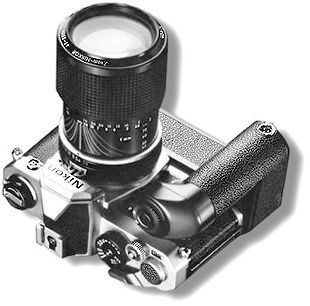
|
Operational ease
is the keynote of the FM. Technological highlight started from a equaled
to F2 standard high tensile strength copper silumin body that can withstand
bumps and hard knocks on the field.
Warning: Before you attempt to use content
in this site as a reference; please ensure your camera is a Nikon FM (1977).
If you are using a newer FM2 or the current FM2n, you should click here
for original FM2 (1982) and FM2n (1983).
|
W A
R N I N G: G-SERIES Nikkor lenses
have no aperture ring on the lens, they with any of these manual focus Nikon FM
series SLR camera models.
A very precise film transport
system which provides a smooth 135° winding at constant torque yet with
durability to handle the pounding speed of a 'new' motor drive system designed
specifically for the FM and the FE at 3.5 fps (The Nikkormat has no motor
drive coupling, but only a slow 2 fps Winder (AW-1) was made available for the last
two electronic EL models - the Nikkormat ELW and the Nikon EL2).
The FM's metering uses
a simple yet un-offensive LED (light emitting
diode) display which works even in low available light without the need for
artificial illumination in the finder. The LEDs are in five combinations
just like the F2AS Photomic. Using a pair of gallium photo diodes housed
just beside the eyepiece, the system features the standard 60/40 center-weighted
sensing pattern and has a metering capability from EV1 to EV18 (i.e. f/1.4,
1 sec. to f/16, 1/1000 sec. when using an f/1.4 lens and ASA 100 film). Easy
and accurate viewing/focusing can be achieved by the standard type K matte
Fresnel screen with a combination microprism/split image spot built into
the fixed eye level finder. Others "master touches" include depth of field
previewing, stop-down metering, multiple exposures and auto indexing, etc.
Compact and reliable, the Nikon FM accepts almost all Nikkor lenses and
most Nikon system accessories. Most of all, it is a pure mechanical camera
and works even without any battery cell(s) installed in the camera.
From its
very inception, it was designed as a flexible standalone system camera.
The camera body incorporates all the controls, terminals, circuits and coupling
devices necessary for accommodating, systematically and naturally, the vast
array of accessories available from Nikon from the past and still able to
tab in the current system dominated by AF design. These include attachments
for flash, close-up and motor-drive accessories, as well as for remote-controlled
shooting. The FM even has its own, compact and lightweight motor drive unit,
the MD-11, which was developed along with it but it is compatible with the
upgrade in MD-12, which is the current model. This patched the vacuum, where
all along, the earlier Nikkormat's apparent weakness in lacking a caliber
motor drive system. While there were upgrades along with the advancement
in respective fields, backward compatibility were always there.
Because
the FM (And all the other models within the FM series - A little reservation
on the current FM10) is being built exceptionally rugged, enduringly reliable,
uncompromisingly precise as evidenced by the million that were still in
use today. Besides being lighter and smaller than the Nikkormat, its comes
with an excellent human engineering design for positive, responsive and
easy handling. Nikkor lenses' F-mount, a major strength and selling point
for Nikon camera, has remained unchanged since its introduction that stretches
back to 1959, these FM models work virtually with all Nikkor lens models
past (Except the OP Fisheyes and Ultra wide Fisheyes Nikkor), present and
even the latest AF-D lenses (The FM, FE (and the bulkier Nikkormat) are
the only two such compact Nikon models that has a adjustable meter coupling
lever to accept past and present Nikkor Lenses. However, started from the
FM2 in 1982 (But Nikon EM was the first Nikon), all other Nikon bodies has
a fixed, nonadjustable meter coupling lever that can only accept AI lenses (or modified) and
the newer series. (Except the professional F4.
However, the current F5 comes with a 'replaceable' fixed ring which can
be altered based on specification).
It is simple, straight
forward and no frills camera. Easy to understand and operate. This site
will go from the utmost basic from preparation of the camera to shot, outline
its various controls and features, explain what can the system accessories
can help you to have a more creative, productive and responsive SLR photography
with this jewel-liked camera from Nikon.
Reflex Viewing :
The Nikon FM utilizes a through-the-lens or TTL viewing system. This simply
means that the image the photographer sees through the lens, through the
viewfinder eyepiece, is the image that will be recorded on the film. A principle
that has made the SLR so popular as compared rangefinder system. Accordingly,
the image changes every time the lens is angled differently and, indeed,
every time a lens with a different focal length is used with the camera.

|
The image
itself appears erect and un-reversed through the FM's fixed eye-level
pentaprism viewfinder; the picture area covered is approximately 93%,
which corresponds to that of a mounted transparency. To compensate for
the difference between the more superior viewing system had in the rangefinder
camera system, SLR manufacturers has spent a lot of development effort in
the viewfinder system to bridge the gap. The FM's image brightness is enhanced
by the use of silver coating on the viewfinder's pentaprism and some special
treatment applied on the viewfinder screen to make the most of TTL viewing
at full aperture.
|
Viewfinder Screen
This is similar to the Type K which is the standard screen for Nikon F2
(but remains as a standard screen for all manual focus Nikon bodies). To
outline the standard Type K screen in details, there are three focusing
"aids" available: (1 ) a Split-image rangefinder spot with a diameter of
3mm, (2) a 1mm wide annular microprism grid, and (3) a fine, matte Fresnel
outfield. You will note that the main focusing"aids" - the spot and the
grid - are placed centrally in the screen, which is often where the main
subject is positioned. This makes focusing considerably fast and easy for
the vast majority of subjects. The split-image rangefinder spot is especially
invaluable for precise, pinpoint focusing. All that is required is to turn
the focusing ring of the lens until the two halves of the portion of the
image framed by the spotcoincide perfectly to form a single, "unbroken"
image. The microprism grid, on the other hand, is best for focusing rapidly
on subject outlines, such as in sports or fast-action photography; image
breakup is quickly noticeable even when the subject is only fractionally
out of focus. In this case, the focusing ring is turned until the portion
of the image seen through the microprism pattern appears crisp. As for the
fine matte outfield, it is particularly useful when shooting with telephoto
lenses that have small aperture, or when doing close-up or microphotography
Although the focusing screen has no condenser, Nikon applied some special
treatment on the matte Fresnel outfield assures the brightness of the entire
view field. In conclusion, the screen of the original FM may not be the
brightest among the lots but its viewfinder screen is adequately makes for
fast, simple focusing for most of your needs.
The FM viewfinder came
with a fixed eye-level pentaprism type with built-in TTL exposure meter.
Essential key information pertaining to shutter speed, aperture setting
indicated in the finder when lens in use is fitted with an aperture-direct-readout
(ADR) lens aperture scale (See the red optical path in the illustration above), LED
display indicates five exposure graduations through combinations of three
symbols (+ & - );
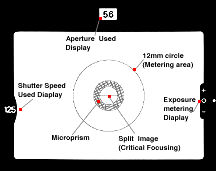
|
The finder
coverage, approx. 93% of the picture field; viewfinder magnification,
0.86X with 50mm lens set at infinity. Matte fresnel field with central
split-image rangefinder surrounded by micro prism ring; 12mm-diameter
reference circle indicates area of meter center-weighting in the 60/40
composition.
|
So much for the bright
side of the viewing system in the FM. However, the main drawback is, the
focusing screen design works a little weak in some small aperture lenses.
Since the focusing screen is not interchangeable type as with the FM2n or
the FE and you can only have the same screen to work. The center split image
tends to darken. In this case, you ought to use the outer fields for focusing
- especially when you are shooting vertically.
Focusing screen design
were eventually enhanced further in later years to brighten the viewing
by almost a full stop with the introduction of the newer type 2 screen when
the FE2 launched in 1983.

|
The early
batch of the Nikon FM upgrade, the original FM2 in 1982, which came with focusing screen
interchange ability were sharing with the type 1 screens which the FE
uses.
|
All other FM series models
(Except the FM10 and the original FM we are discussing right now, unfortunately
the Nikon FM was not able to enjoy that extra benefit, because it was designed
with a fixed, non-interchangeable standard type K screen mentioned above.
You may check the focusing screen section for further info.
Depth-of-field (DOF)
preview
Conveniently shaped in the form of a lever and positioned for easy, coordinated
activation by either the right index or middle finger, this control, when
pressed, 'stops down' (A photographic term which means close the iris diaphragm
of the blades in the lens) the lens to its taking aperture.
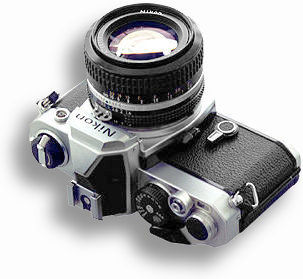
|
The photographer
can then see exactly which elements of the picture will appear in sharp
focus in the actual photograph, even though some of them may have appeared
otherwise prior to pressing the lever. This is a clear departure from
the mechanical Nikkormat FT series, where the DOF preview is via a button
located at the top of the camera. It was not the first, the electronic
Nikkormat EL series were already adopted this in 1972.
|
While the lever is kept
pressed, the lens iris is not wide open (unless, of course, the photographer
has set the lens to its maximum aperture); naturally, the image in the viewfinder
'darken' and will become even more so as smaller apertures (i.e., bigger
f/numbers) are set. Note that you get more depth of field with smaller apertures.
It should be mentioned that the selective use of depth of field through
lens aperture manipulation, in accordance with any given picture-taking
situation, is a significant camera operation since it is often closely connected
with the creative effects that will be found in the actual picture. The
FM's depth-of-field preview control has another function. It is used for
stop-down (i.e., not at full aperture) exposure measurement with Nikkor lenses
that do not have the AI (automatic aperture indexing, where a lens will automatically
set to its largest aperture when mount to the camera for brightest possible
image for view and focusing, stop down to the actual aperture value when
you trip the shutter release button for an exposure) facility. This is an
indispensable feature when you are frequently involved with creative depth
of field priority assignments. For instance, close up, portraiture photography.
Reflex Mirror Mechanism
Although the FM is not the tiniest lot of the compact SLRs available in
the market. But at its relatively compact body, it houses a very large reflex
mirror in its main chamber. Employing a unique retraction system, the mirror's
hinge mechanism moves back, then up, as the mirror itself flips out of the
optical path when a picture is taken. This system, which was originally
proven on the F2, has made it possible for the FM to employ a reflex mirror
with a PO value* (see illustration) that is substantially larger
than what one would expect in such a compact camera. Note also how the aperture
direct readout (ADR) works.
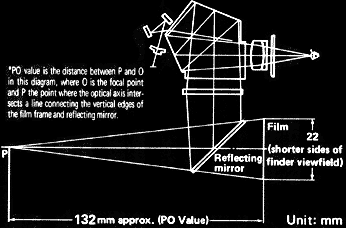
|
The advantage of this extra-large
size is that there is no image cutoff when the photographer uses a super-telephoto
lens as long as 800mm or such close-up accessories as bellows and extension
tubes for high magnification works. Noise and shock during the mirror's
movement are further absorbed by the use of an air-damper in the mirror
box. The mirror's back itself is specially treated to prevent flare-forming
reflections off the back when the mirror is in the flip up position.
|
It should likewise be pointed
out, too, that in motor-drive photography, it is the mirror mechanism that
takes most of the punishment of the pounding motor drive. The FM's mirror
mechanism, which is based on that of the reliable professional F2, is more
than tough enough to take the demanding tension in motorized photography
of up to 3.5 frames per second.
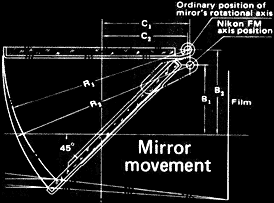
|
However
that since the FM omitted the a mirror lock up mechanism as with all the
earlier Nikon (Including all the Nikkormat), some of the special lenses
like the 6mm f/5.6 and 10mm f/5.6 fisheye Nikkor cannot be mounted onto
the camera body.
|
Metering
The logical extension of TTL viewing is TTL metering. Virtually all modern
cameras are now adopted with this principle in their respective metering
system, which only differs by complexity and methods used, this applies
to the rangefinder cameras as well (Asahi Pentax pioneered this technique,
but Topcon was the first to launch a model commercially). Not only does
it free the photographer from the burden of having to make complicated exposure
calculations with external handheld meters in some complex lighting conditions.
With the exposure indicators readily visible inside the viewfinder, you
can readily get basic key exposure information relates while you are taking
the picture. The Nikon FM's built-in meter, powered by a pair of Gallium
Photo Diodes, located near the eyepiece in the viewfinder, operates on the
principle of Nikon 60/40 center-weighted exposure measurement to provide
quite accurate and responsive exposure measurement.
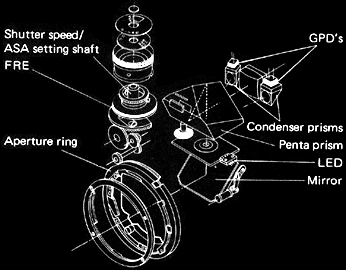
|
The meter reads the intensity of
the light coming through the lens over the entire viewfinder screen, with
its sensitivity (60%) is concentrated on the central area (12mm) outlined
on the screen (Balance 40% shared across the whole picture frame, that
is how the term 60/40 metering composition came from - the standard metering
pattern adopted by virtually all manual focus metered Nikon bodies (there
are few models used average meter in early days and variations in either
75/25 or 80/20 combinations) until the arrival of a revolutionary metering
method in the Nikon FA's Multi Segments Metering
in 1983).
|
This method of exposure measurements has shown itself to be the most effective
for achieving correct exposures in everyday picture-taking situations. The
metering system, has very similar way with the electronic EL series cameras,
which over the years tested and polished up a a lot during early days of
computer circuitry for SLR automation. The adoption of some Nikon developed
solid-state devices such as GPD photo sensors, Nikon's Functional Resistance
Element (FRE) and a monolithic IC, all of which contribute to the FM's compactness
and reduced weight, as well as tackling over a fairly wide range of light
levels from EV 1 to EV18.

|
Also, regardless
of whether metering is at full aperture or stopped down, you can have
all the basic exposure information right there inside the viewfinder.
The exposure indicators are in the form of a five combination LED display
which lights up to indicate the precise degree of overexposure or underexposure,
or correct exposure.
|
The selected shutter speed
is also indicated, as is the set aperture (in the case of Nikkor lenses
with the Al facility). The meter can be switched on by moving the film advance
lever, an action that will uncover a red dot; it can be switched off by
pressing the lever all the way flush it back with the body.
LED display and ADR facility
The main advantage
of the FM's exposure readout facility - the five-combination LED display
- is that it enables clear and easy readings even in extra-dim or extra-bright
light,something the more conventional needle-centering or matching-needles
will find hard put to equal.
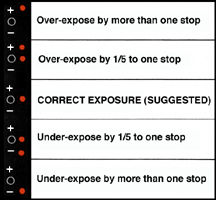
|
Inside
the viewfinder are three exposure indicators : '+' for overexposure, '0' for correct exposure and '-' |









